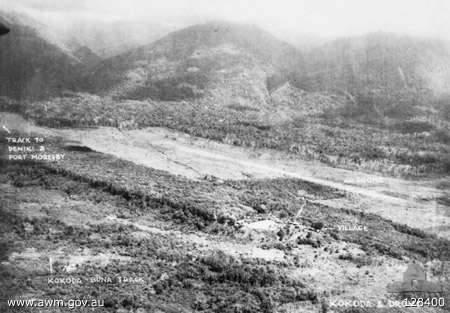A Background To Trekking The Kokoda Track
 Ange Recchia is preparing for the trip of a lifetime, trekking the famed Kokoda trail in Papua New Guinea.
Ange Recchia is preparing for the trip of a lifetime, trekking the famed Kokoda trail in Papua New Guinea.
This post is a part of a series that seeks to provide a historical background to the trek, and why it is important to Australians.
The track was the scene of fierce battles between Australian and Japanese forces in 1942 and 1943.
Ange writes about her plans here, and about how she feels.
The Kokoda track stretches for 96 kilometres or about 60 miles, in a north/south direction, across the Owen Stanley ranges in Papua New Guinea.
Crossing very rugged terrain, it reaches an altitude of 2,190 metres (7,190 feet). Ange is planning to complete the trip in just 8 days.

Image: Kokoda Village and Airstrip July 1942. Australian War Memorial
A VERY brief historical background!
Prior to the attack on Pearl Harbour, the United States, Britain, Holland (through the Dutch Government in Exile) and Australia had placed an embargo on the sale of oil, iron ore and steel to Japan.
This embargo was put in place in order to pressure Japan into ceasing its aggression in China.
The country was faced with the prospect of economic collapse, or war.
Japan took control of French Indo China in September 1940 in an attempt to isolate China, and on September 27 of that year, joined the Axis alliance with Germany and Italy.
Hong Kong fell on December 25, and US bases on Guam and Wake island fell at around the same time.
In January, Japan invaded Burma, the Dutch East Indies (now Indonesia), New Guinea and the Solomon Islands.
Singapore fell on February 15, 1942, with an estimated 130,000 Australian, British, and Dutch personnel being taken prisoner.
 Papua had been a territory of Australia since 1906, and after World War 1 was combined with German New Guinea to form the Territory of Papua New Guinea, eventually gaining independence in 1975.
Papua had been a territory of Australia since 1906, and after World War 1 was combined with German New Guinea to form the Territory of Papua New Guinea, eventually gaining independence in 1975.
Whether Japan actually intended to invade Australia or not is still being debated.
They had certainly intended to isolate Australia and New Zealand.
Accusations were made against the Menzies government of being prepared to cede Australia’s north to the Japanese.
Right: An army recruitment poster from 1940!
The area to be ceded was north of the Brisbane line, which stretched across the continent from east to west from Brisbane.
John Curtin’s Labour Government, which came to power in October, 1941, turned to the US for help.
Curtin also denied Britain’s attempt to retain control of Australian forces abroad, withdrawing them instead to defend Australia.
References (Wikipedia):
Military History of Australia WW2
More in this series…
Preparing For An Expedition To New Guinea
There will be more in this series over the coming weeks.
The first of these posts will provide a further background, including an explanation of terms used here and so on.

